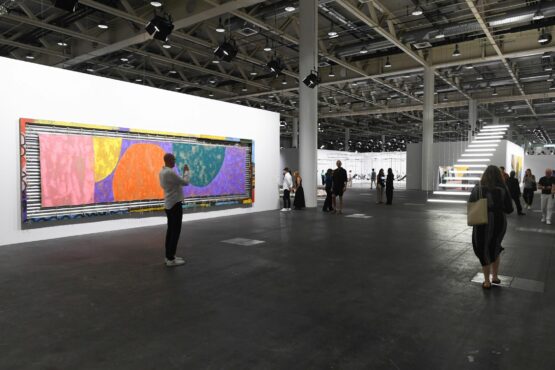In the face of high borrowing rates, geopolitical instability and volatile economic conditions, the global art market still managed to notch an estimated $65 billion in sales in 2023, according to a joint report from Art Basel and UBS Group. That’s the good news.
Less encouraging is the fact that sales, which include those via auctions and art galleries alike, are down 4% in value from 2022. And that’s not factoring in inflation, which could mean the real value of the market’s contraction is more severe.
ADVERTISEMENT
CONTINUE READING BELOW
“I was actually slightly pleasantly surprised that it didn’t decline more,” says the report’s author Clare McAndrew, speaking in reference to the nominal 4% decline. “Talking to people in the last quarter of last year especially, it was pretty tough.”
A view of the 2023 edition of Art Basel. Image: Dave Benett/Getty Images Europe
McAndrew, the founder of the research and consulting firm Arts Economics, says the 2023 art market was in many respects the opposite of the year prior: “In 2022, it was definitely the high end doing much better and everything else kind of slowing,” she says, in reference to works priced in the millions of dollars. “And then we saw that kind of turn on its head a little bit last year, with the high end really kind of thinning out, but there still was activity going on at that kind of lower price level.”
Global declines
The US maintained its dominant art world position, representing 42% of sales by value (which includes both primary and secondary markets), according to the report. And despite a series of high-profile auction flops – including the Long Museum’s disappointing sale at Sotheby’s in Hong Kong – China managed to surpass the UK as the second-biggest market, with its share rising to 19%; the UK sank to third place, with 17%.
France came in a distant fourth, with 7% of sales by value, totalling $4.6 billion in sales.
Success is more than market share, though: In terms of total dollar amount, the US market declined by 10%, totalling $27.2 billion, according to the report.
Sales in the UK fell nearly as much by share of value, some 8%. Only China, which McAndrew says benefited from a backlog of sales due to Covid-related lockdowns, saw a 9% growth in value in 2023 to $12.2 billion. But once that inventory belatedly hit the market in the spring, the Chinese market began to sink quickly, too.
“In the second half of the year, the auction segment was much flatter,” McAndrew says. Without that early spring spike, she continues, “it would have been a much, much worse year in China, and a much worse year globally as well.”
Beleaguered trophy market
The 1 600 dealers surveyed who self-reported results – results that, therefore, should be taken with a grain of salt – told the researchers that their aggregate sales fell by about 3% year-over-year, to $36.1 billion. The pain was particularly pointed for dealers who had more than $10 million in turnover; they reported a 7% decline in average sales.
Meanwhile, smaller operations, that is, dealers with a turnover of less than $500 000, saw sales rise by 12% on average.

Visitors at the Basel art fair. Image: Harold Cunningham/Getty Images Europe
ADVERTISEMENT
CONTINUE READING BELOW
The slowdown of higher-priced sales could have serious ramifications for the overall gallery ecosystem, says Noah Horowitz, chief executive officer of Art Basel. “We’re seeing a sense of costs outpacing pricing in terms of what galleries are able to turn around and sell,” he says, citing transport, shipping, travel and entertainment as factors that contribute to rising overhead.
“Doing business has gotten more challenging, and prices aren’t quite keeping pace with the increasing cost of business.”
Global auction figures also suffered from a pullback at the highest end. Total public auction sales fell by 7%, to $25.1 billion, according to the report, and sales over $10 million were a major factor in that decline; the number of lots sold in that tier fell by 25% from the previous year, while total values decreased by a staggering 40%.
“I think people did hold back from selling at auction if they could,” McAndrew says.
Looking ahead
And yet transactions did occur, and the art market is still chugging along – the volume of sales actually increased by 4% year-over-year, according to the report.
Much of what happens with that trend could hinge on the market’s robust (and largely unquantifiable) ecosystem, McAndrew suggests: “There’s a nice mix in the art market of the experience and the product. It’s got a dual nature, in that it’s buying something, but it’s the whole process that goes with buying it.”
She cites the thrill of bidding at auction or the fun of travelling to an art fair in a warmer climate.
“It mixes experiences with products in a very positive way. I think that’s what’s going to save it,” she says.
Not every dealer is so optimistic. Only about a third of the report’s respondents expected an improvement in sales in 2024, and they have an even grimmer view of their peers: Just 23% predicted that their competitors would see a rise in sales.
© 2024 Bloomberg

